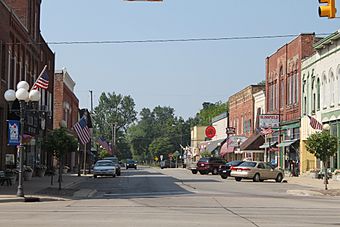Blissfield Downtown Historic District facts for kids
Quick facts for kids |
|
|
Blissfield Downtown Historic District
|
|
 |
|
| Location | Roughly bounded by Pearl, Jefferson, Giles and Adrian Sts., and the Blissfield railroad line, Blissfield, Michigan |
|---|---|
| Architectural style | [ |
| NRHP reference No. | 15000364 |
| Added to NRHP | June 29, 2015 |
The Blissfield Downtown Historic District is a special area in the village of Blissfield, Michigan. It's like a time capsule of old buildings. This district is roughly bordered by Pearl Street, Giles Avenue, Jefferson Street, and Adrian Street, including the Blissfield railroad line. It was added to the National Register of Historic Places in 2015. This means it's officially recognized as an important historical place in the United States.
Contents
What is a Historic District?
A historic district is a group of buildings, structures, or sites that are important because of their history or architecture. They often show how a town or city looked and functioned in the past. Keeping these areas safe helps us learn about history.
Buildings in the District
The Blissfield Downtown Historic District has 44 buildings that are considered historically important. There are also eight newer buildings that are not part of the historical count. Many of these buildings were built a long time ago, starting around 1875. Most of the area grew and developed in the late 1800s and early 1900s.
What Kinds of Buildings Are There?
This district holds most of the buildings that were used for business in Blissfield during that time. You can find old shops, offices for doctors or lawyers, and places where people went for fun. There were also buildings for clubs and other social groups.
Architectural Styles You Can See
The buildings in the district show off popular building styles from when they were built. These styles include:
- Italianate: Buildings with tall, narrow windows and decorative brackets under the roof.
- Late Victorian: Often colorful and highly decorated, showing off the wealth of the time.
- Arts and Crafts: Simple, sturdy designs that focus on natural materials and handmade details.
- Commercial Brick: Strong, practical buildings made mostly of brick, common for businesses.
Some of these buildings are excellent examples of these styles and have been kept in great condition. They help us see how architecture changed over time.



